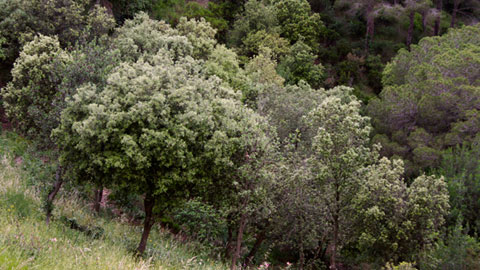Spain has close to seven billion trees

The figure comes from the National Forest Inventory, a Spanish Ministry of Agriculture project, involving the UAB's Centre for Ecological Research and Forestry Applications (CREAF), to measure the country's forestry resources in terms of biomass, carbon stocks, sink capacity and biodiversity.
03/09/2015
There are an estimated 6,971,283,041 trees in Spain, according to the latest National Forest Inventory (IFN3), conducted by the Spanish Ministry of Agriculture, Food and the Environment between 1997 and 2008. This count did not take into consideration young trees of less than 75mm in diameter (diameter of the trunk measured at a height of 1.30m.), following the IFN3 methodology.
Catalonia is the autonomous community with the second-highest tree population: 1,035,407,888 trees, surpassed only by Castilla y León – nearly three times larger than Catalonia – with 1,210,642,112 trees. The reason, explains Jordi Vayreda, a CREAF researcher, is that "Catalonia has a large forest area, some of which is very dense."
In fact Catalonia is one of the autonomous communities with the highest tree density: 637 trees per hectare, alongside La Rioja (694 trees/ha) and Cantabria (653 trees/ha). The dominant tree species over the whole of Spain is the holm oak, making up 19.12% of the total number of trees. In Castilla y León and Catalonia, the percentages are similar (17.1% and 24.4% respectively).
This data is from the National Forest Inventory, a Spanish Ministry of Agriculture project to measure the country's forestry resources in terms of biomass, carbon stocks, sink capacity and biodiversity, among others. Fifty years after its first edition, the IFN has become the most accurate and exhaustive of all systems used to monitor the state of Spanish woodland.
The project is organised by provinces and collects the same data in 10-year periods for the whole of the country. A CREAF team coordinated by, among others, Jordi Vayreda, collaborated with the IFN3 Inventory by providing supplementary information on ecological indicators. Currently the field sampling for the fourth inventory (IFN4) is under way in Catalonia, and it is expected to be complete by the end of 2015.
Catalonia is the autonomous community with the second-highest tree population: 1,035,407,888 trees, surpassed only by Castilla y León – nearly three times larger than Catalonia – with 1,210,642,112 trees. The reason, explains Jordi Vayreda, a CREAF researcher, is that "Catalonia has a large forest area, some of which is very dense."
In fact Catalonia is one of the autonomous communities with the highest tree density: 637 trees per hectare, alongside La Rioja (694 trees/ha) and Cantabria (653 trees/ha). The dominant tree species over the whole of Spain is the holm oak, making up 19.12% of the total number of trees. In Castilla y León and Catalonia, the percentages are similar (17.1% and 24.4% respectively).
This data is from the National Forest Inventory, a Spanish Ministry of Agriculture project to measure the country's forestry resources in terms of biomass, carbon stocks, sink capacity and biodiversity, among others. Fifty years after its first edition, the IFN has become the most accurate and exhaustive of all systems used to monitor the state of Spanish woodland.
The project is organised by provinces and collects the same data in 10-year periods for the whole of the country. A CREAF team coordinated by, among others, Jordi Vayreda, collaborated with the IFN3 Inventory by providing supplementary information on ecological indicators. Currently the field sampling for the fourth inventory (IFN4) is under way in Catalonia, and it is expected to be complete by the end of 2015.